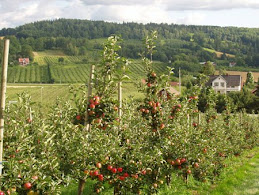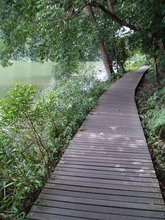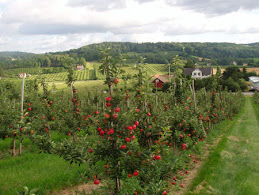By Bryna Singh, brynasim@sph.com.sg, The Straits Times, Mon, 13 July 2015
Seletar Airport's one-storey passenger terminal will soon make way for a new two-storey facility with better amenities.
Photo: The Straits Times, Published on 12 July 2015 at 5:00 am SGT
https://blogger.googleusercontent.com/img/b/R29vZ2xl/AVvXsEickcvXm-LUOisW-PYTuXMB5yU_SKE6of9A36TO5hyphenhyphenMpJtM3OiS9Z5IaVu9y9ZQ8PnZqrDrHAlm8eT8LMqZB3sscIjCEbL6hXD0ZmhT2YXS49vTygj15OWwb5v_DQxJ0WN2tzE8JYvixh8/s1600/seletarairport_st.jpg
http://s3-travel-production.s3-ap-southeast-1.amazonaws.com/styles/relax_620x413_thumbnail/s3/article/images/featured/seletarairport_st.jpg?itok=kxoWLpRA
http://travel.asiaone.com/article/news/so-long-old-seletar-airport
With hard, plastic seats in its open-air visitor arrival area, a single drinking fountain, a two-counter immigration check-in area and no food or beverage options in sight, Seletar Airport looks like an airport from another country - a smaller, less developed one.
Miles away from the busy metropolitan hub that is Changi Airport, it retains a rustic vibe that speaks of simpler, more modest times.
About 20 years ago, it cost less than 10 cents an hour to park a small plane at this airport. Animals from the leafy surrounds roamed the unfenced runway, and planes waited for them to cross before taking off.
PHOTO: ST FILE
https://blogger.googleusercontent.com/img/b/R29vZ2xl/AVvXsEjiUmdSVE6B-IZ7E05twivTy7zM6NV2RSM5IU3H6HjcwRXXDdcLJLyzeJnYulsv92bQLxhMJdaKl-_sQFGR2dRqasQncwPhs_ocDU_XCZgIPlfVRvh9hXoSPrN6T8kMcfd679yEiopR4bg/s1600/ST_20150712_BSAIR_1500926.jpg
http://www.straitstimes.com/sites/default/files/styles/x_large/public/articles/2015/07/12/ST_20150712_BSAIR_1500926.jpg?itok=OAuiglM5
http://www.straitstimes.com/lifestyle/so-long-old-seletar-airport
No wonder the airport's old- timers are lamenting that a slice of Singapore history and an important part of its aviation heritage will be gone when it was reported that the single-storey passenger terminal at the airport will be torn down soon.
A new two-storey facility with better amenities will take its place in the middle of 2017.
Officially opened in 1930, Seletar Airport handles mainly private and pilot training flights.
The upgrade - slated to begin this year - will see the new Seletar Airport equipped to handle its steadily growing traffic, and relieving some of the load on Changi's runways.
Picture posted by Travelfish.org on 15 November 2014
https://blogger.googleusercontent.com/img/b/R29vZ2xl/AVvXsEic2c6hp9c7JxHmv2mpp0L5VfSsSVpUlfmLfuy0kCNCZ_B_Lpj3m6QELctZ7HK3-LvG5vlObB24Zb-E5u30F_dfq32FzCDt4p2YAklibYXfPsGEGTrhyphenhyphenZt0_LGM07HW_T8ECHcQBReuw6A/s1600/Seletar-a.jpg
http://travelfish-sg.s3.amazonaws.com/blogs/singapore/wp-content/uploads/2014/02/Seletar-a.jpg
http://www.travelfish.org/sight_profile/singapore/central_region/central_area/greater_singapore/2012
In the first nine months of last year, Seletar Airport handled about 18,000 passengers. It had about 22,000 for the whole of 2013.
In the airport's history, aviation pioneers and modern-day celebrities alike have graced its tarmac. In 2001, actors Tom Cruise and Penelope Cruz cruised into the airport on a private jet to publicise their movie Vanilla Sky.
Others say they have spotted Microsoft founder Bill Gates and singer Bruno Mars. In March this year, former Indonesian president Megawati Sukarnoputri flew here to pay her last respects to Mr Lee Kuan Yew.
In 1930, Ms Amy Johnson - the first woman to fly solo from Britain to Australia - made a stopover at Seletar.
Checkpoint inspector Kadis Jumanain, 53, a clearance supervisor at Seletar Airport with the Immigration & Checkpoints Authority, says: "Working here, you get to see people, planes and incidents that you don't get to see often."
In his 1 1/2 years working at the airport, he has seen people with critical injuries and gunshot wounds being flown in on air ambulances, and dead bodies being flown out.
And then there were the animals.
Mr Gary Ho, 40, was a trainee air traffic controller there between 1999 and 2001. He recalls the entire airport being an unfenced open space in the past.
Chickens, dogs and even the occasional python would cross the runway just as a plane was about to take off.
"We would just have to wait, but if it was a particularly stubborn snake, we'd call the Agri-Food and Veterinary Authority of Singapore to help get rid of it," he says.
Mr Jeyapala Machap, 48, deputy chief of Seletar Tower, Civil Aviation Authority of Singapore, recalls an incident in the 1990s when there was a cow on the loose.
It had wandered in from one of the neighbouring farms surrounding the airport and had run across the runway.
"It was caught, but it eventually died from stress. No one came looking for it though," he says.
For plane spotters and aviation geeks, Seletar Airport was probably the best place to see rare models such as vintage military planes and turboprops, which are planes with propellers in front.
Mr Lim Poh Ghee, 55, who did an apprenticeship with the then Singapore Aerospace Maintenance Company between 1977 and 1980, used to refurbish planes such as early models of the C-130, Hunter and Skyhawk. He is now a senior lecturer in Aeronautical & Aerospace Technology at Nanyang Polytechnic's School of Engineering.
Some of these planes had been acquired by the company after the Vietnam War and were ridden with bullet holes and even bullets in some cases.
Mr Jeyapala was thrilled to see a Vickers Vimy aircraft land at the airport some time in the 1990s. After all, the aircraft had first featured in World War I as a British heavy bomber plane.
"It had two sets of wings and propellers made of wood. It was a pure pleasure for me to see it fly," he recalls.
Many of the old airport staff paint a picture of a close-knit community. From ground handlers and emergency crew to pilots, immigration officers and air traffic controllers, most of them knew one another by name.
There also used to be friendly football matches and flying competitions between the flying clubs located in the area. The clubs competed to see whose aircraft could land the closest to a marker on the runway, says Mr Jeyapala.
In fact, the larger Seletar Aerospace Park, which Seletar Airport is part of, was its own small town in the 1980s.
Mr Mohandas Ramanathan, 52, who served his national service at Seletar Camp in 1983 and was later an instructor at the Singapore Flying College between 1999 and 2002, has many fond memories of the airport.
He says there used to be a canteen, a fuel station with two pumps and a tailor shop next door that repaired military uniforms.
"There were also these 'pirate taxis' that would take you into the grounds from the gate for just $1," says the programme chair for the diploma in Aviation Management at Republic Polytechnic.
Backtrack a few more decades and the compound even had a school, cinemas, a bank and a swimming pool within its grounds.
The year 2000 was the turning point, as taller buildings and larger hangars were built as the area developed.
The homelier aspects of Seletar Aerospace Park disappeared, such as its humble petrol kiosk, tailor shop and pirate taxis, as the authorities cracked down on the illegal service.
While many can understand the need for a bigger and better Seletar Airport, there are those who say they will miss the vintage charm of the place.
Mr Jeyapala says driving through the old gate that led one into the current Seletar Aerospace Park was like driving into the countryside, where goose-necked street lamps lined the single-lane road.
Although his Seletar Airport days are behind him, Mr Ho, who is a senior lecturer in Aviation Management & Services at Temasek Polytechnic, says he is very sad that the airport faces the wrecking ball.
He takes his students there so they can see a different side of Singapore's aviation heritage.
"They are always very shocked, because many of them think every airport is like Changi. Alas, a part of history is going. All good things come to an end," he says.
Posted by wheelandaxle in Bus Services, SBS Transit on 3 April 2013
https://blogger.googleusercontent.com/img/b/R29vZ2xl/AVvXsEj8dadRT-Of4XybVvXbdg8Q_sm0_yv6tuB837Ns7q3YKVny5Am5b-StJZQUayA1dLcV1Va1IAtFlLBpA-ls_H5ZpoJ13GH0bQW10v5dhcXqOjR_B5qY10b0Zu5IZyd6-g8p89IGVGnNmXs/s1600/18793906752_9eac3aa6e6_k.jpg
https://farm1.staticflickr.com/377/18793906752_9eac3aa6e6_k.jpg
https://publictransportsg.wordpress.com/2013/04/03/service-103/
Airport milestones
1923: The Straits Settlements government gives the British government a 243ha site for a Royal Air Force station in Seletar. The site consists of 202.5ha of land planted with coconut and rubber trees and 40.5ha of mangrove swamp.
1928: The first planes to land at Seletar on Feb 28 are four Supermarine Southampton seaplanes, or "flying boats". These planes had flown for 4 1/2 months across about 14,500 km from Plymouth and were on a journey known as the Far East Flight.
1930: Singapore's first airport officially opens as a British Royal Air Force base on Jan 1, 1930.
On Feb 10, Seletar Air Base receives its first commercial flight - a Dutch East Indies Airways plane carrying eight passengers from Jakarta. This makes it both a civilian airport and military airbase.
1941: The Japanese bomb the Seletar airfield at 4am on Jan 8. This is the first British air base they strike.
The Japanese military takes control of the air base, and returns it to the British in 1945.
1968: The British begin to hand over operations of the air base to the Singapore Government.
In 1971, the airbase is officially handed over, and is under the administration of the then Department of Civil Aviation.
1977: On Oct 29, four armed Vietnamese hijack an Air Vietnam flight carrying 36 passengers from Ho Chi Minh City to Singapore. The aircraft lands at Seletar Airport.
The hijackers eventually surrender to Singapore authorities, but not before two Vietnamese crew members are killed and a third person seriously injured.
2007: The Seletar Aerospace Park project is launched, with plans for Seletar Airport and its surrounding areas to be developed into a premier aerospace hub in the region.
Upgrading plans include a longer runway, a new control tower and fire station, with the number of parking stands doubled and additional taxiways.
2009: Changi Airport Group takes over management of the airport from the Civil Aviation Authority of Singapore, previously known as the Department of Civil Aviation.
2011-2012: The extension of the Seletar Airport runway (above) by 250m to 1.84km is completed, as is the construction of a new fire station and new control tower on the east side of the runway. The old control tower was built before World War II.
2014-2015: Plans are announced last year to upgrade Seletar Airport as part of a bigger plan to increase the efficiency of Changi Airport.
The Straits Times reports on June 9 this year that the single-storey passenger terminal at Seletar Airport will be torn down and a new two-storey facility with better amenities will be ready by mid-2017.
Sources: The Straits Times, National Library Board
e-Resources, Seletar Airport website, Singapore Infopedia, and Changi Airport Group media releases
This article was first published on July 12, 2015.
Get a copy of The Straits Times or go to straitstimes.com for more stories.
Picture posted by Travelfish.org on 15 November 2014
https://blogger.googleusercontent.com/img/b/R29vZ2xl/AVvXsEisTYkQBRYQHXQ_jy6DX5SQXjZB8sbkRQ7WDr7sh60k8mdj3p_z4f0sSebogOxjnUCF6Tz-ZRyagEmWw4NNM-u2P99pmk36h0Yqbw0nIq6zP_amyI4s6bNpIFNUajuaL0fdzcaGnp2L5Lw/s1600/Seletar-b.jpg
http://travelfish-sg.s3.amazonaws.com/blogs/singapore/wp-content/uploads/2014/02/Seletar-b.jpg
http://www.travelfish.org/sight_profile/singapore/central_region/central_area/greater_singapore/2012
Reference
- https://blogger.googleusercontent.com/img/b/R29vZ2xl/AVvXsEickcvXm-LUOisW-PYTuXMB5yU_SKE6of9A36TO5hyphenhyphenMpJtM3OiS9Z5IaVu9y9ZQ8PnZqrDrHAlm8eT8LMqZB3sscIjCEbL6hXD0ZmhT2YXS49vTygj15OWwb5v_DQxJ0WN2tzE8JYvixh8/s1600/seletarairport_st.jpg
- http://s3-travel-production.s3-ap-southeast-1.amazonaws.com/styles/relax_620x413_thumbnail/s3/article/images/featured/seletarairport_st.jpg?itok=kxoWLpRA
- http://travel.asiaone.com/article/news/so-long-old-seletar-airport
- https://blogger.googleusercontent.com/img/b/R29vZ2xl/AVvXsEjiUmdSVE6B-IZ7E05twivTy7zM6NV2RSM5IU3H6HjcwRXXDdcLJLyzeJnYulsv92bQLxhMJdaKl-_sQFGR2dRqasQncwPhs_ocDU_XCZgIPlfVRvh9hXoSPrN6T8kMcfd679yEiopR4bg/s1600/ST_20150712_BSAIR_1500926.jpg
- http://www.straitstimes.com/sites/default/files/styles/x_large/public/articles/2015/07/12/ST_20150712_BSAIR_1500926.jpg?itok=OAuiglM5
- http://www.straitstimes.com/lifestyle/so-long-old-seletar-airport
- https://blogger.googleusercontent.com/img/b/R29vZ2xl/AVvXsEic2c6hp9c7JxHmv2mpp0L5VfSsSVpUlfmLfuy0kCNCZ_B_Lpj3m6QELctZ7HK3-LvG5vlObB24Zb-E5u30F_dfq32FzCDt4p2YAklibYXfPsGEGTrhyphenhyphenZt0_LGM07HW_T8ECHcQBReuw6A/s1600/Seletar-a.jpg
- http://travelfish-sg.s3.amazonaws.com/blogs/singapore/wp-content/uploads/2014/02/Seletar-a.jpg
- http://www.travelfish.org/sight_profile/singapore/central_region/central_area/greater_singapore/2012
- https://blogger.googleusercontent.com/img/b/R29vZ2xl/AVvXsEj8dadRT-Of4XybVvXbdg8Q_sm0_yv6tuB837Ns7q3YKVny5Am5b-StJZQUayA1dLcV1Va1IAtFlLBpA-ls_H5ZpoJ13GH0bQW10v5dhcXqOjR_B5qY10b0Zu5IZyd6-g8p89IGVGnNmXs/s1600/18793906752_9eac3aa6e6_k.jpg
- https://farm1.staticflickr.com/377/18793906752_9eac3aa6e6_k.jpg
- https://publictransportsg.wordpress.com/2013/04/03/service-103/
- https://blogger.googleusercontent.com/img/b/R29vZ2xl/AVvXsEisTYkQBRYQHXQ_jy6DX5SQXjZB8sbkRQ7WDr7sh60k8mdj3p_z4f0sSebogOxjnUCF6Tz-ZRyagEmWw4NNM-u2P99pmk36h0Yqbw0nIq6zP_amyI4s6bNpIFNUajuaL0fdzcaGnp2L5Lw/s1600/Seletar-b.jpg
- http://travelfish-sg.s3.amazonaws.com/blogs/singapore/wp-content/uploads/2014/02/Seletar-b.jpg
- http://www.travelfish.org/sight_profile/singapore/central_region/central_area/greater_singapore/2012














































.jpg)
.gif)
.jpg)





















































%20-%20%E5%82%B7%E5%BF%83%E7%9A%84%E8%B7%AF%20(Sh%C4%81ng%20x%C4%ABn%20de%20l%C3%B9)%20-%20The%20Road%20of%20Sorrow%20(With%20Subtitle)_11.png)


